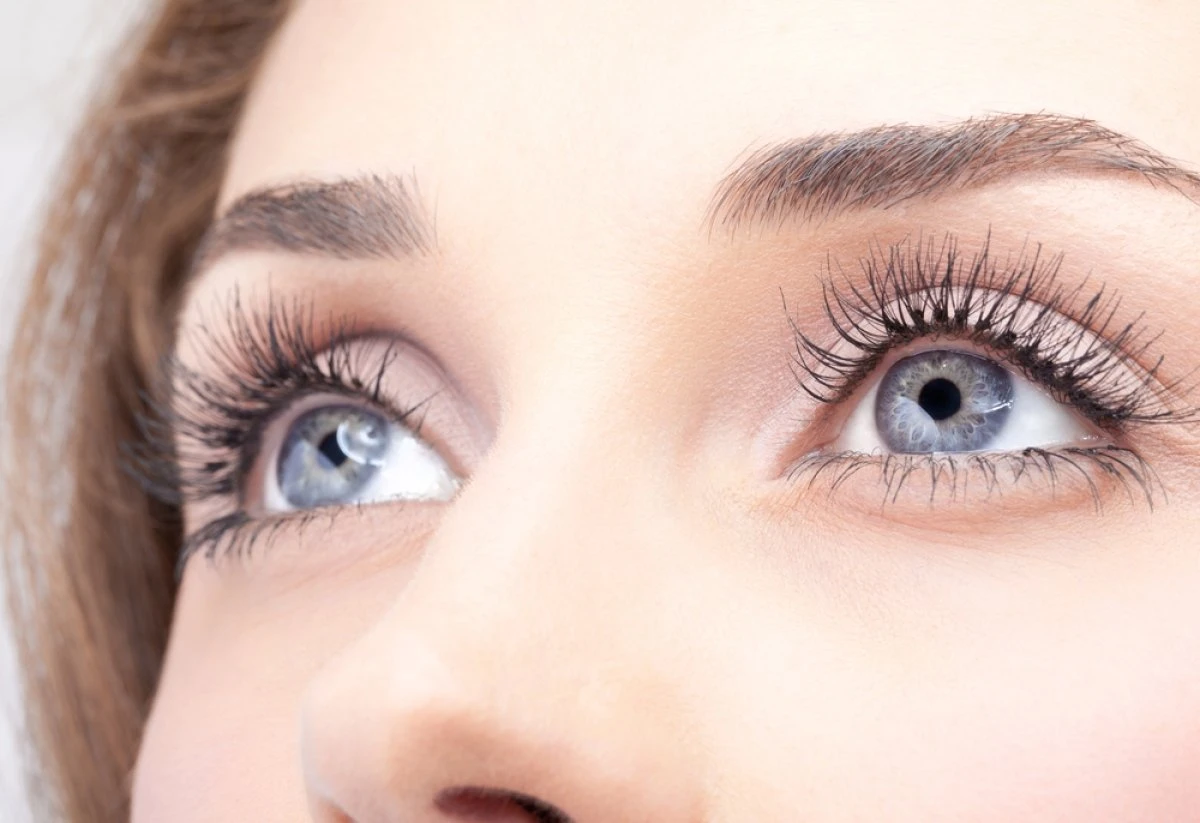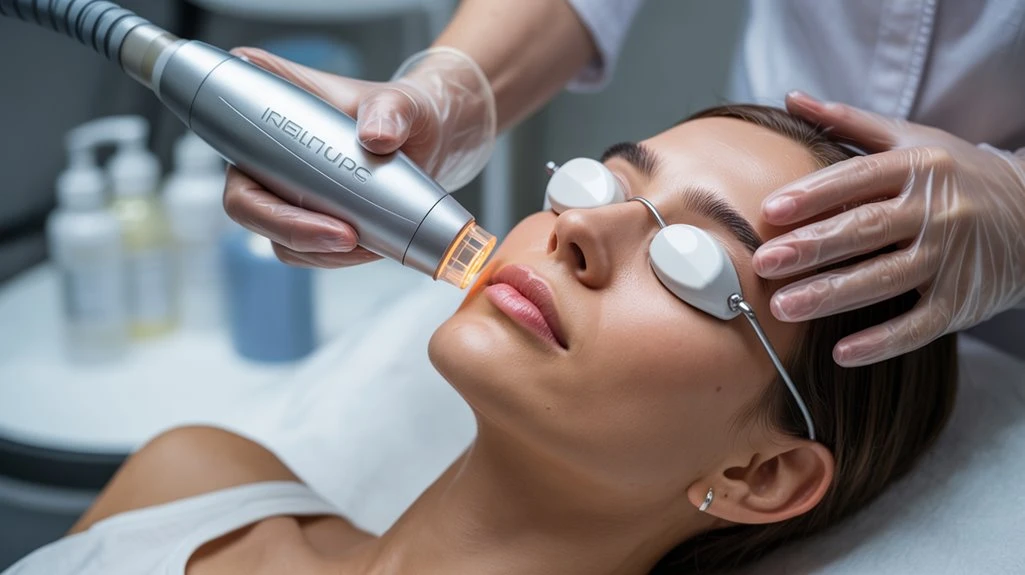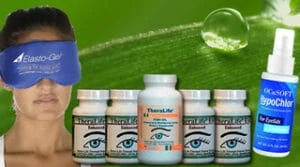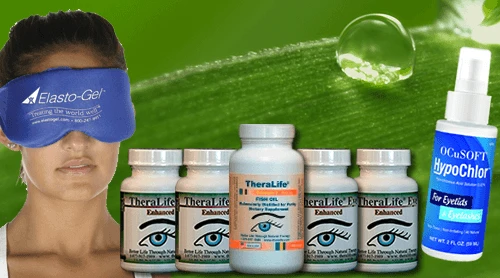Theralife offers a unique approach to treating ocular rosacea, focusing on oral eye treatment care that sets it apart from other solutions. Theralife’s products are designed to address eye conditions from the inside out, promoting overall eye health and alleviating symptoms such as inflammation and discomfort. As the only company providing this type of oral treatment, Theralife ensures that customers receive comprehensive care for their eye conditions.
For instance, their products help improve tear film stability and reduce symptoms associated with ocular rosacea, like burning and irritation. Theralife’s treatment options are clinically validated, providing customers with relief and improved quality of life. Whether you are dealing with blepharitis, dry eyes, or other related conditions, Theralife’s targeted solutions offer an effective alternative to more conventional therapies. If you’re interested in how Theralife can benefit your eye health, explore their range of products and discover a tailored approach to managing your symptoms.
Powerful Ocular Rosacea Relief With TheraLife
Chronic dry eye is a significant feature of ocular rosacea.
Treating dry eyes will reduce inflammation and keep ocular rosacea under control
Key Takeaways
- IPL (Intense Pulsed Light) is a light-based therapy used to treat inflammation in ocular rosacea, especially targeting meibomian gland dysfunction.
- The treatment works by delivering light pulses to the periocular skin, coagulating abnormal blood vessels and reducing eyelid inflammation.
- IPL helps improve tear film stability, alleviates eyelid margin redness, and often relieves symptoms better than traditional therapies.
- Candidates are typically patients with moderate to severe ocular rosacea who do not respond to standard treatments like warm compresses or antibiotics.
- Multiple sessions are usually required, and mild side effects like redness or swelling may occur but typically resolve quickly.
Understanding Ocular Rosacea and Its Symptoms
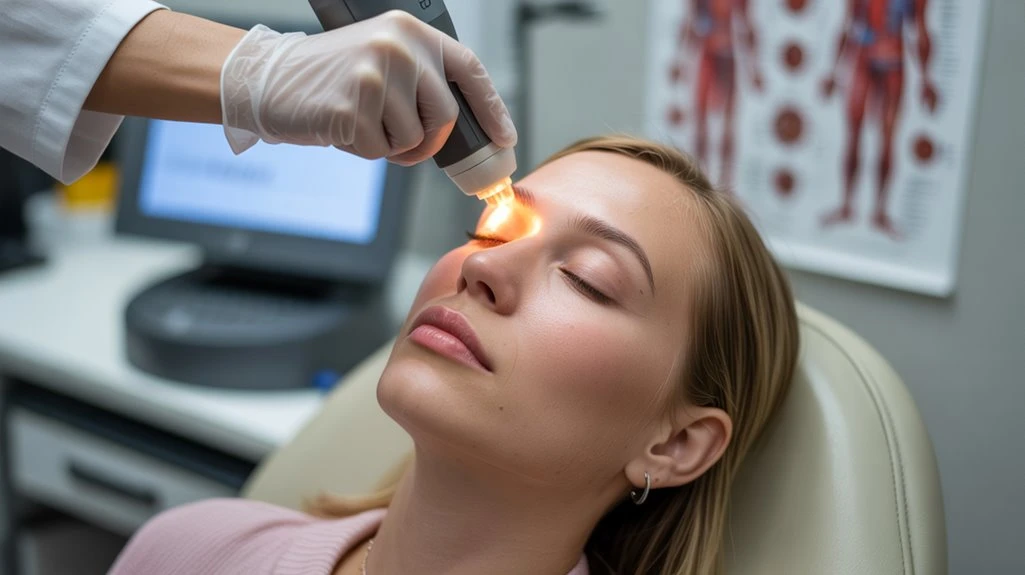
Although ocular rosacea often goes undiagnosed, it manifests as chronic inflammation of the eyelids and ocular surface, leading to symptoms such as eyelid margin erythema, telangiectasia, meibomian gland dysfunction, and recurrent chalazia.
You’ll notice that the pathogenesis involves dysregulation of the innate immune response and increased vascular permeability, which causes ocular rosacea. Common ocular rosacea triggers include ultraviolet light exposure, spicy foods, alcohol, extreme temperatures, and emotional stress, all of which can exacerbate inflammation.
Clinically, patients present with burning, foreign body sensation, photophobia, and fluctuating vision. Chronic meibomian gland dysfunction reduces lipid secretion, destabilizing the tear film and increasing evaporative dry eye.
Recurrent chalazia and styes are hallmark findings. Early identification and management of triggers are essential for mitigating disease progression and symptoms. Neutrophil extracellular traps contribute to pathological changes in dry eye, further complicating ocular rosacea management.
How Intense Pulsed Light (IPL) Therapy Works
When conventional therapies for ocular rosacea prove insufficient, Intense Pulsed Light (IPL) therapy offers a targeted approach to alleviating meibomian gland dysfunction and periocular inflammation.
IPL technology utilizes polychromatic, non-coherent light pulses delivered to the periocular skin. These pulses penetrate the dermis, selectively targeting abnormal telangiectatic blood vessels that contribute to inflammation and glandular obstruction.
The thermal effect of IPL coagulates these vessels, reducing inflammatory mediator release and improving meibomian gland secretion quality. As a result, tear film stability often improves, and ocular surface symptoms diminish.
If you’ve found limited relief from standard treatment alternatives, IPL technology may provide a clinically validated option for symptom management.
Treatment protocols are individualized based on severity, with procedures typically performed in multiple sessions for ideal therapeutic outcomes.
In addition to IPL therapy, high delivery states of MGD linked to hypersecretion can significantly impact oil quality, necessitating comprehensive treatment strategies to manage symptoms effectively.
The Science Behind IPL’s Effectiveness for Eye Conditions
You’ll find that IPL’s therapeutic effects stem from its targeted light energy, which attenuates periocular inflammation and vascular abnormalities. Clinical studies indicate IPL improves meibomian gland function by reducing abnormal blood vessels and stabilizing the tear film. This mechanism addresses two primary pathophysiological factors in ocular rosacea. Additionally, hot compresses serve as a natural remedy to alleviate symptoms by unclogging meibomian oil glands and enhancing the effectiveness of treatments.
Light Energy and Inflammation
Because intense pulsed light (IPL) delivers controlled wavelengths of light energy to periorbital skin, it targets abnormal blood vessels implicated in ocular rosacea. When IPL is applied, specific light wavelengths are absorbed by hemoglobin, leading to coagulation of telangiectatic vessels. This photothermal effect reduces vascular inflammation and limits the release of pro-inflammatory mediators, ultimately modulating the local inflammation response. It’s important to note that ocular rosacea can lead to serious complications if left untreated, underscoring the need for early intervention and management.
Here’s a visual summary:
| Mechanism | Clinical Impact |
|---|---|
| Absorption by hemoglobin | Vessel coagulation, reduced redness |
| Photothermal effect | Diminished vascular leakage |
| Modulation of cytokines | Decreased local inflammation response |
Meibomian Gland Function
Although IPL is traditionally associated with dermatological applications, its impact on meibomian gland function has emerged as a key mechanism in treating ocular surface disease.
When you suffer from meibomian gland dysfunction (MGD), the glands along your eyelid margins fail to secrete appropriate lipid content, causing tear film instability and evaporative dry eye.
IPL targets the underlying vascular and inflammatory components contributing to MGD. By delivering controlled light pulses, IPL reduces abnormal telangiectasia and peri-glandular inflammation, which can restore normal glandular secretion and improve tear film quality.
Coupled with consistent eyelid hygiene, IPL can enhance gland patency and secretion expression.
Evidence suggests that IPL, when integrated with eyelid hygiene practices, considerably alleviates MGD symptoms, optimizes ocular surface health, and improves overall patient comfort.
Research highlights the role of cytokines in tear fluid and their correlation with MGD severity, providing further insight into the underlying mechanisms of dry eye disease.
What to Expect During an IPL Treatment Session
During an IPL treatment session for ocular rosacea, the clinician will first assess your skin and ocular surface to determine ideal settings and guarantee safety.
They’ll apply a cooling gel to the treatment area and fit protective eyewear to shield your eyes from light pulses.
Using advanced IPL techniques, the device emits controlled, high-intensity pulses of broad-spectrum light targeting abnormal blood vessels and periocular inflammation.
Most patient experiences describe a mild snapping or warming sensation during each pulse, lasting only a few milliseconds.
Sessions typically last 15–20 minutes. The clinician may adjust energy settings based on your skin type and response, optimizing efficacy and minimizing adverse effects.
Post-treatment, mild redness or swelling may occur, but these effects usually resolve within a few hours.
Uveitis can result in vision loss if untreated, making early intervention crucial for effective management.
Benefits of IPL Therapy for Ocular Rosacea
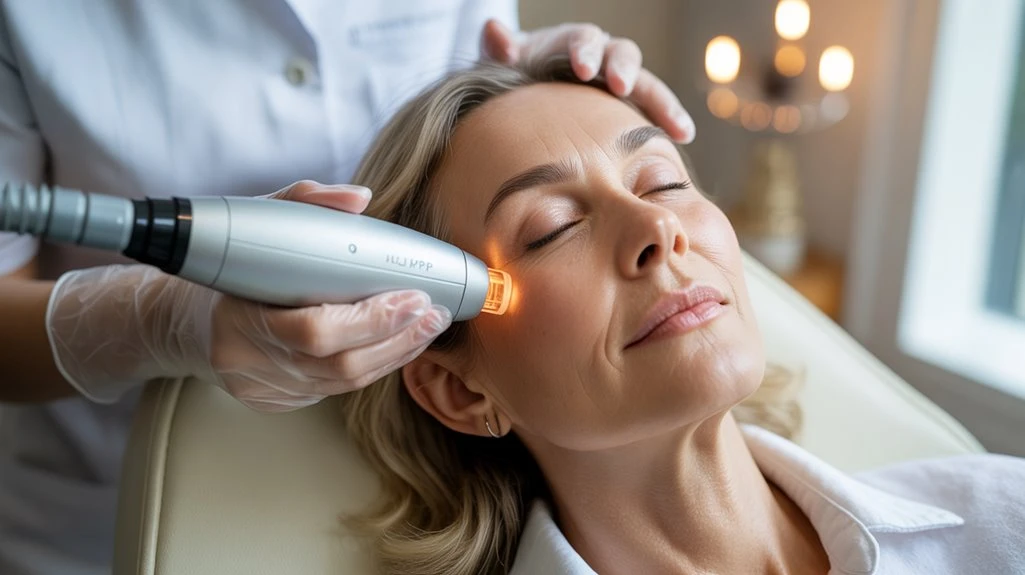
Once you’ve completed an IPL treatment session, you can expect several clinically significant benefits for ocular rosacea. Studies show that IPL therapy effectively reduces lid margin telangiectasia, alleviates meibomian gland dysfunction, and improves overall tear film stability. You’ll likely notice diminished redness, less ocular surface irritation, and a decrease in inflammatory lesions based on patient experiences reported in clinical trials. When considering treatment comparisons, IPL frequently outperforms traditional therapies—such as warm compresses and topical antibiotics—by directly targeting abnormal vasculature and chronic inflammatory pathways. Many patients report improved visual comfort and a marked reduction in symptoms after a series of sessions. These evidence-based outcomes make IPL a promising adjunct or alternative for managing refractory ocular rosacea, enhancing quality of life and long-term disease control. Furthermore, regular eyelid hygiene practices, such as lid margin massage and warm compresses, can complement IPL therapy by further enhancing meibomian gland function and tear film stability.
Potential Side Effects and Risks of IPL
Caution is warranted when considering IPL therapy for ocular rosacea, as the procedure carries specific risks and potential side effects.
You may experience transient erythema, edema, or discomfort in the treated area. Some patients report ocular surface irritation, dry eye exacerbation, or temporary visual disturbances.
More severe potential complications include ocular burns, pigmentary changes, or scarring, especially if protective measures are insufficient. While most side effects are mild and self-limiting, rare instances of persistent symptoms have been documented.
It’s crucial to weigh these risks against the benefits and discuss treatment alternatives, such as oral antibiotics, topical agents, or lifestyle modifications. Proper hydration is vital for ocular surface health, which may aid in reducing flare-ups and maintaining moisture balance.
Careful patient selection and adherence to safety protocols can mitigate adverse events, but informed consent remains critical before proceeding with IPL therapy.
Who Is a Good Candidate for IPL Treatment?
You’ll want to contemplate IPL treatment if you have moderate to severe ocular rosacea symptoms that haven’t responded to conventional therapies. Your candidacy also depends on your overall ocular surface health and any coexisting eye conditions. An ophthalmologist will assess these factors to determine if IPL is appropriate for you. Blepharitis treatment often involves dietary changes and eyelid hygiene, which might also be considered when evaluating your condition.
Severity of Ocular Symptoms
Although ocular rosacea presents with a broad spectrum of symptom severity, candidates for IPL treatment typically exhibit moderate to severe manifestations that are refractory to standard therapies.
You may notice persistent symptoms such as pronounced eyelid margin inflammation, chronic conjunctival hyperemia, and significant meibomian gland dysfunction.
Symptom triggers often include environmental factors or lifestyle elements, but when these are controlled and severe ocular irritation persists, it suggests your condition might benefit from advanced intervention.
Traditional treatment options—like lubricating eye drops, oral tetracyclines, or topical anti-inflammatories—may not sufficiently alleviate your discomfort if your disease process is advanced.
IPL is generally reserved for individuals whose ocular surface disease impacts daily activities and quality of life, and who need a more targeted approach to reducing chronic inflammation and abnormal vascularity.
Incorporating stress management techniques such as yoga and meditation can also help minimize flare-ups and support overall symptom management.
Previous Treatment Responses
When conventional therapies—such as lubricating drops, topical cyclosporine, oral doxycycline, or warm compresses—fail to provide sustained relief from ocular rosacea symptoms, you may be an appropriate candidate for IPL treatment. Clinical evidence indicates that patients who have exhausted previous treatment options without satisfactory outcomes often experience chronic eyelid inflammation and persistent ocular surface disease. Evaluating your response to prior therapies helps determine IPL suitability, as this intervention is typically reserved for refractory cases. Reviewing patient experiences and treatment histories enables clinicians to stratify candidates likely to benefit from IPL.
| Previous Treatment Options | Common Patient Experiences |
|---|---|
| Lubricating eye drops | Temporary relief, frequent recurrence |
| Oral doxycycline | Incomplete response, GI side effects |
| Warm compresses | Minimal improvement, inconvenience |
Overall Eye Health
Because IPL treatment for ocular rosacea targets underlying vascular and inflammatory mechanisms, clinicians assess overall eye health to determine candidacy.
You’ll undergo a thorough ocular examination to evaluate tear film stability, meibomian gland functionality, and ocular surface integrity.
Adequate eye nutrition—ensuring sufficient intake of omega-3 fatty acids, antioxidants, and essential vitamins—supports peak ocular surface health, which can enhance IPL efficacy.
Hydration importance is emphasized, as sufficient systemic hydration maintains tear film homeostasis and reduces evaporative stress on the ocular surface.
Candidates with unmanaged lid disease, severe dry eye, or significant ocular surface compromise may not be ideal for IPL.
If you maintain good eye nutrition, prioritize hydration, and have stable ocular health, you’re more likely to benefit from IPL for ocular rosacea.
Preparing for Your IPL Therapy Appointment
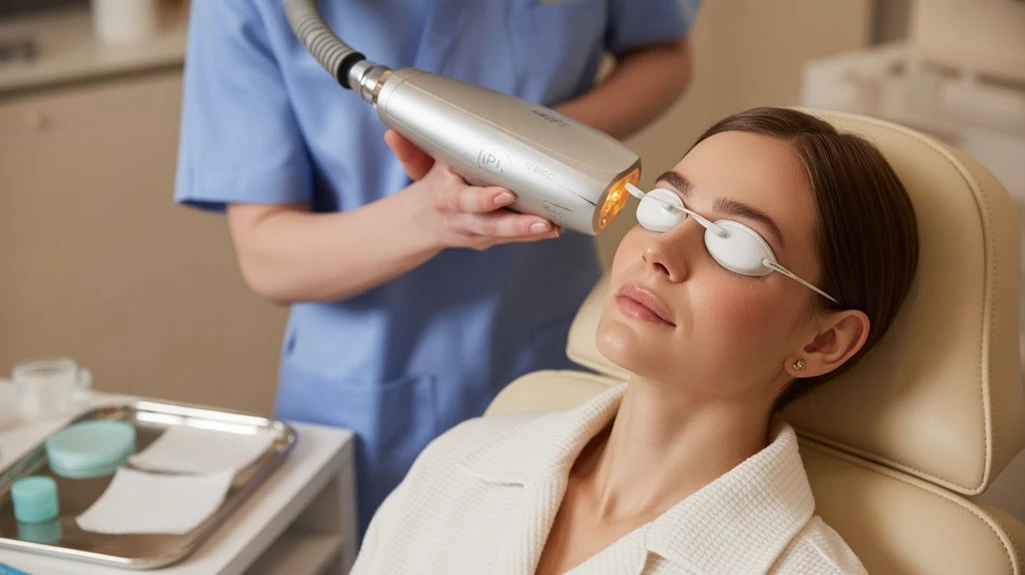
Several specific steps will help you improve your results from IPL therapy for ocular rosacea.
Begin by adhering to a pre-appointment checklist provided by your ophthalmologist. This typically includes discontinuing topical retinoids, avoiding sun exposure, and ceasing use of photosensitizing medications as directed.
Arrive at your session without eye makeup, creams, or lotions on the periocular area to prevent interference with the device’s efficacy. You should inform your provider about any recent ocular procedures or active infections to guarantee patient safety.
To enhance patient comfort, discuss analgesic options or cooling methods with your clinician in advance.
Wear loose clothing for facial accessibility and bring protective eyewear if instructed.
Following these clinical protocols guarantees maximum treatment efficacy, minimizes adverse events, and promotes a seamless procedural experience.
Aftercare and Managing Results Following IPL
A thorough aftercare regimen is essential for optimizing your outcomes and minimizing complications following IPL treatment for ocular rosacea.
Immediately post-procedure, you should avoid direct sun exposure and apply broad-spectrum sunscreen to reduce the risk of hyperpigmentation and erythema.
Use artificial tears to alleviate transient ocular dryness and refrain from rubbing your eyes.
Adhere strictly to your provider’s aftercare tips, including avoiding makeup and contact lenses for at least 24 hours.
Monitor for adverse events such as persistent edema, pain, or visual disturbances, and report these promptly.
Managing expectations is vital—improvements in telangiectasia and meibomian gland function typically manifest gradually over multiple sessions.
Consistent follow-up appointments facilitate assessment of therapeutic efficacy and allow for timely intervention if complications arise.
Powerful Ocular Rosacea Relief With TheraLife
Chronic dry eye is a significant feature of ocular rosacea.
Treating dry eyes will reduce inflammation and keep ocular rosacea under control
Frequently Asked Questions
How Much Does IPL Treatment for Ocular Rosacea Typically Cost?
When you consider IPL treatment for ocular rosacea, you’ll find costs typically range from $300 to $600 per session.
Cost factors include the number of sessions required, severity of your condition, and specific treatment locations—urban clinics often charge more.
Insurance rarely covers this procedure, as it’s considered elective.
Always consult with a board-certified ophthalmologist to assess your suitability and obtain an accurate estimate based on your individual clinical presentation.
Is IPL Therapy Covered by Insurance for Ocular Rosacea?
You might expect insurance policies to support every clinically indicated therapy, yet IPL therapy for ocular rosacea often falls outside standard treatment eligibility.
Insurers usually classify IPL as an elective or cosmetic procedure, despite its evidence-based efficacy in reducing meibomian gland dysfunction and ocular surface inflammation.
Unless your policy specifically lists IPL as medically necessary, you’ll likely face out-of-pocket costs.
Always verify coverage with your insurance provider before initiating treatment.
Can IPL Be Used With Other Rosacea Treatments, Like Antibiotics?
You can combine IPL with other rosacea treatments, such as oral or topical antibiotics, to enhance IPL effectiveness.
Clinical studies support treatment combinations, showing improved control of ocular rosacea symptoms and reduced inflammation when therapies are used together.
However, you should consult your ophthalmologist or dermatologist to tailor an individualized regimen, monitor for adverse effects, and optimize outcomes, as response to combination therapy can vary depending on disease severity and patient-specific factors.
How Many IPL Sessions Are Usually Needed for Noticeable Improvement?
You’ll typically need three to five IPL sessions, spaced about three to four weeks apart, to achieve noticeable improvement in ocular rosacea symptoms.
Session frequency and improvement timeline can vary based on the severity of your condition and individual response to therapy.
Evidence supports that cumulative treatments target abnormal blood vessels and inflammation, leading to gradual symptom relief.
Your ophthalmologist will tailor the protocol to optimize both efficacy and safety for your unique ocular presentation.
Are There Any Long-Term Restrictions After IPL Treatment for Ocular Rosacea?
Studies show that over 80% of patients experience sustained symptomatic relief, but you should still consider long-term effects and post treatment care.
You won’t face significant long-term restrictions after IPL, but ophthalmologists advise ongoing eyelid hygiene and UV protection to maintain results.
Rarely, chronic dryness or pigmentary changes can occur, so it’s essential you attend regular follow-ups.
Adhering to individualized care protocols optimizes ocular surface stability and minimizes adverse sequelae.
Powerful Ocular Rosacea Relief With TheraLife
Chronic dry eye is a significant feature of ocular rosacea.
Treating dry eyes will reduce inflammation and keep ocular rosacea under control
Conclusion
TheraLife offers a unique approach to eye care by providing oral treatment solutions, setting itself apart as the only company to do so. Their products are designed to target and alleviate conditions like ocular rosacea from the inside, promoting eye health and comfort. The efficacy of TheraLife’s natural solutions is supported by clinical studies, which demonstrate significant improvements in conditions such as meibomian gland dysfunction and ocular inflammation. By choosing TheraLife, patients benefit from a holistic approach that not only addresses symptoms but also works to restore overall eye health. If you’re seeking a path to clearer vision and comfort, TheraLife’s oral treatment options may be your ideal solution.
REFERENCES
- 1.Two AM, Wu W, Gallo RL, et al. Rosacea: part I. Introduction, categorization, histology, pathogenesis, and risk factors. J Am Acad Dermatol. 2015;72:749–760; quiz 759–760. [DOI] [PubMed] [Google Scholar]
- 2.Culp B, Scheinfeld N. Rosacea: a review. P T. 2009;34:38–45. [PMC free article] [PubMed] [Google Scholar]
- 3.Alvarenga LS, Mannis MJ. Ocular rosacea. Ocul Surf. 2005;3:41–58. [DOI] [PubMed] [Google Scholar]
- 4.Vieira AC, Mannis MJ. Ocular rosacea: common and commonly missed. J Am Acad Dermatol. 2013;69:S36–S41. [DOI] [PubMed] [Google Scholar]
- 5.Rainer BM, Kang S, Chien AL. Rosacea: epidemiology, pathogenesis, and treatment. Dermatoendocrinol. 2017;9:e1361574. [DOI] [PMC free article] [PubMed] [Google Scholar]
- 6.Webster GF. Rosacea. Med Clin North Am. 2009;93:1183–1194. [DOI] [PubMed] [Google Scholar]
- 7.Heisig M, Reich A. Psychosocial aspects of rosacea with a focus on anxiety and depression. Clin Cosmet Investig Dermatol. 2018;11:103–107. [DOI] [PMC free article] [PubMed] [Google Scholar]
- 8.Wilkin J, Dahl M, Detmar M, et al. Standard classification of rosacea: report of the national rosacea society expert committee on the classification and staging of rosacea. J Am Acad Dermatol. 2002;46:584–587. [DOI] [PubMed] [Google Scholar]
- 9.Geng RSQ, Slomovic J, Bourkas AN, et al. Ocular rosacea: the often‐overlooked component of rosacea. JEADV Clin Pract. 2024;3:1349–1363. [Google Scholar]
- 10.Patel NV, Gupta N, Shetty R. Preferred practice patterns and review on rosacea. Indian J Ophthalmol. 2023;71:1382–1390. [DOI] [PMC free article] [PubMed] [Google Scholar]

